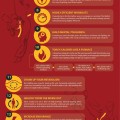Please enjoy a guest post from Albert Guardado Jr. from Combat Brands. We believe self-defense is vital for each and every person.
No one likes to think about the idea of being attacked, but the reality is that, according to the FBI, a violent crime is committed every 26.3 seconds in America, with one aggravated assault every 41.3 seconds. These numbers aren’t intended to scare you — though they are indeed alarming — but should instead help you understand why preparation and vigilance are vital in our sometimes threatening world.
One of the simplest ways to conquer a frightening situation is to learn some key self-defense tactics that you can file away in your mental rolodex if a situation should arise.

1. Get Comfortable With Martial Arts
When you think about self-defense classes, there’s a good chance that you envision a tough-looking instructor in a gi (the uniform traditionally associated with karate and other martial arts), possibly taking down a grappling dummy in a decidedly badass move. There’s a reason why we associate self-defense with the martial arts — the two are closely linked, as many martial arts evolved from or into self-defense mechanisms over time. There is, of course, much more to martial arts than defense, but most self-defense practices are rooted in traditional, unarmed fighting arts like karate.
Taking classes in Krav Maga, kickboxing, Muay Thai, boxing, judo or karate, or signing up for a dedicated self-defense program, can help you learn some simple self-defense strategies. You may also want to think about training at home — finally, an excuse to buy those boxing gloves you’ve been eyeing! — or hosting a social self-defense night with a professional trainer and a group of friends. At the end of the day, learning traditional techniques will help ensure that you get out unscathed and may even introduce you to a sport that you’ll want to practice for life.
2. Be Armed, Literally and Metaphorically
One primary reason why self-defense is and should remain separate from karate and other martial arts is because there may need to be some weaponry involved in your self-defense approach. That doesn’t necessarily mean that you should go out and purchase a handgun, but instead that you should arm yourself with simple tools — such as a self-defense keyring or a canister of pepper spray — to ward off predators. You should also consider investing in a personal safety app on your phone to alert others if you find yourself in a dangerous situation. However, your own body — your fingers in a predator’s eyes, for example — is your best, most reliable weapon.
3. Carry Yourself Confidently
Another great way to (metaphorically) arm yourself is to respond to a threatening scenario in a way that affects your attacker. Confidence is one of the most important facets of self-defense, yet it’s one that many people struggle with. Unfortunately, for many of us, it just doesn’t feel natural to face a frightening scenario with a tough, straight face.
But walking, talking and holding yourself with confidence — especially trusting your own ability to respond correctly in a violent scenario — is enough to convince yourself and the potential threat that you’re nothing to mess with.
In every situation where you feel unsafe, do your best to thwart confrontation so that it doesn’t escalate. For example, you might practice target denial, where you change your course — crossing the street to get away from a threatening figure, perhaps — to make yourself less accessible.
You’ll also want to set some boundaries so that a threat doesn’t view you as an “easy target,” like making it clear verbally that the aggressor’s behavior and close proximity are not welcome. A simple “stop talking to me,” is better than silence, which can be viewed as weak or subdued behavior.
4. Have a Plan of Attack and Practice
Planning and preparation are vital to any endeavor, but especially self-defense. One primary reason why many people opt to go through a structured self-defense program is because instructors are able to train with real-life scenarios, helping you learn how to cement your response strategy in your mind and muscle memory.
Develop a plan of attack — and make sure that you practice it regularly with dummies or fake opponents — so that you have a simple, go-to response for everything an attacker may throw your way. Going through mock scenarios will help you decide when to go on the offense, when to go on the defense and when to employ your weapons.
5. Know How to Think Fast
The most important aspects of self-defense are undoubtedly how to get your attacker off of you or how to compromise his or her strength so that you can get away. But you also need to train yourself to know when it’s safe to flee. Often, in threatening scenarios, victims want to get as far away from the assailant as possible, and that’s a good instinct to have. Unfortunately, though, sometimes that’s not a viable option, such as when an attacker is armed and may be tempted to shoot if and when you run.
Know that getting away should be your primary objective, but it may not always be wise to do so. On the same token, remember to never defend your personal property — it’s much easier to replace your smartphone than it is to replace your life!
Final Thoughts
The only thing that matters is that, when the ordeal is over, you’re safe and sound. Know that, while you may not experience anything scarier in your lifetime, there’s a good chance that you’ll make it out of the situation in one piece — 87 percent of people who resist verbal or forceful assault are successful, even with no training. Entering the scenario with a little bit of know-how, confidence and quick thinking will set you up for success so that you come out unharmed.
Bio
Albert Guardado Jr. is a retired boxer and current Product Support Supervisor for Combat Brands. Albert oversees the product portfolio for all three branches of Combat Brands. He was a member of the 1996 U.S. Olympic Boxing Team (Atlanta, GA) and former member of USA Boxing’s Board of Directors. Albert is a three time USA Boxing National Champion, as well as the 1992 National P.A.L. Champion. He also medaled in the 1993 World Championships, 1994 Goodwill Games and 1995 Pan-American Games. Albert continues to share his extensive boxing knowledge by coaching, blogging and assisting with tournament administration at events supported by Combat Brands.












